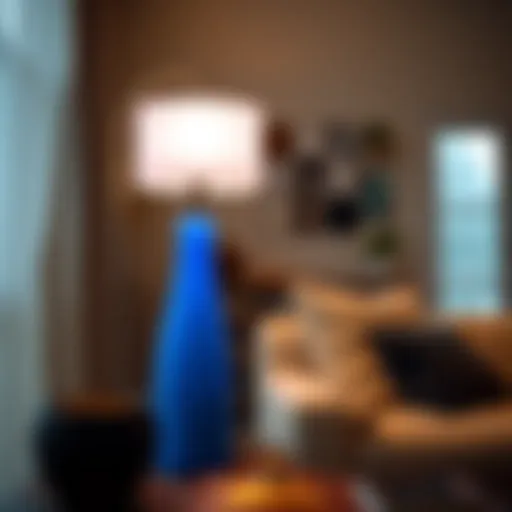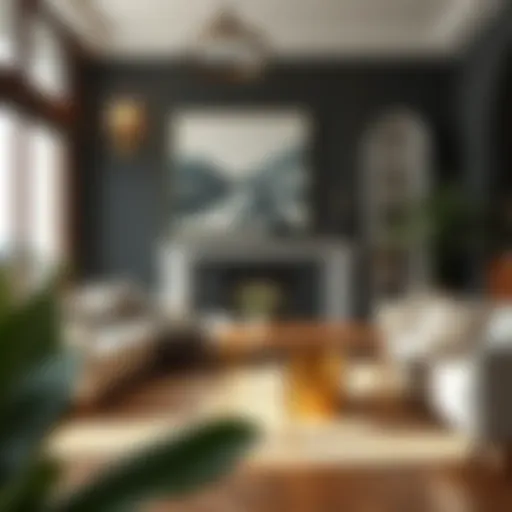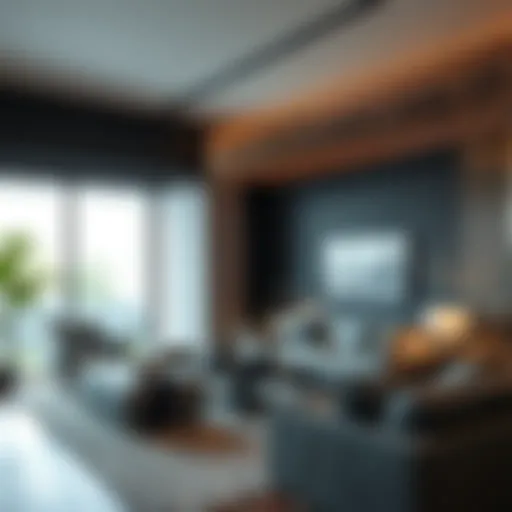Exploring the Role of Overhead Lighting in Design


Intro
Lighting serves as the backbone of interior design, shaping how we perceive and interact with our spaces. Overhead lighting, in particular, plays a significant role in both functionality and aesthetics. It’s not just about illumination; it’s about creating an atmosphere that resonates with comfort, style, and purpose.
When you step into a room, the first thing that often catches your eye isn’t the furniture or decor; it’s the lighting overhead. Be it a cozy cottage or a sleek urban apartment, the type and quality of overhead lighting can dramatically transform a space, making it feel alive and inviting. From recessed lights to chandeliers, the options available today are abundant, yet choosing the right overhead fixture requires a deeper understanding of how different styles can complement or clash with your existing themes.
Furthermore, advancements in technology have led to innovative solutions, offering smart lighting options that enhance not only the look but also the efficiency of your home. Sustainability has emerged as a major factor in lighting choices as well, prompting consumers to consider eco-friendly options that reduce energy consumption without compromising on design quality. Through this exploration, we’ll delve into various aspects of overhead lighting:
- Types of overhead lighting: Understanding the various fixtures available, their unique characteristics, and best uses.
- Applications in diverse environments: How the choice of lighting varies between different rooms and settings.
- Aesthetic vs. utility: Balancing design elements with the practical aspects of lighting in everyday use.
- Tech advancements and sustainability: Insight into how modern innovations shape our lighting choices and long-term benefits of sustainable options.
- Practical tips: Guidance on selecting and installing overhead lighting to enrich your living spaces.
By the end of this exploration, readers will grasp the intricate dance between overhead lighting’s functionality and its aesthetic appeal. Beyond mere illumination, it’s about crafting a narrative through light—setting the mood, elevating design, and enhancing our everyday experiences.
Furniture Trends
Current Market Trends
As the way we live and work evolves, so does the style of our interiors. Overhead lighting has jumped to the forefront of home design, with market trends now leaning towards versatile and functional options. Homeowners look for fixtures that not only brighten their spaces but also serve as statement pieces.
In recent years, there has been a noticeable shift toward minimalistic designs. People seem to gravitate towards fixtures that boast clean lines and a modern aesthetic. These designs often blend seamlessly with a variety of decor styles, offering flexibility that homeowners appreciate. Additionally, multi-functional lighting solutions are on the rise, such as fixtures that incorporate both ambient and task lighting, catering to various needs in a single design.
Popular Styles and Designs
When it comes to popular styles, a plethora of options has emerged:
- Industrial: Fixtures made from metals and exposed bulbs bring an urban edge, creating a compelling contrast against softer decor.
- Scandinavian: Characterized by simplicity and natural elements, these designs emphasize light, making spaces feel airy and uncluttered.
- Luxe/Art Deco: Opulent designs with rich materials and intricate details appeal to those wanting to make an extravagant statement.
- Vintage/Retro: Lighting fixtures that reflect historical styles, offering a nostalgic charm beloved by many.
- Smart Lighting: With a growing trend toward tech-savvy homes, smart lighting that can change colors and settings via smartphone apps has taken the market by storm.
Overhead lighting has transformed from just a necessity to an essential element of design, and understanding these trends enables homeowners to make informed decisions that reflect their personalities and lifestyles.
Prolusion to Overhead Lighting
Overhead lighting serves as the backbone of illumination in any given space, dictating the mood, functionality, and aesthetic appeal of our homes and workplaces. It’s like the cherry on top of a beautifully crafted dessert—essential yet often overlooked. By providing a uniform layer of light, overhead fixtures not only enhance visibility but also play a crucial role in highlighting architectural features and design schemes.
When we talk about overhead lighting, we point toward a wide variety of options that adapt to diverse needs and settings. Understanding these options can empower homeowners, renters, designers, and DIY enthusiasts alike, allowing them to make informed decisions that breathe life into their spaces. Moreover, the importance of overhead options extends beyond mere utility; it intertwines deeply with the core of interior design principles, affecting how spaces feel and function.
As this article unfolds, we will explore several facets of overhead lighting, from its definitions to the latest technology trends. By dissecting types, applications, and aesthetic considerations, we aim to provide a comprehensive overview that demystifies overhead lighting for all audiences. Remember, the goal is not merely to install a light fixture but to create an environment that resonates with warmth and style.
Defining Overhead Lighting
Overhead lighting refers to fixtures that are mounted on ceilings or high above the floor, offering broad illumination across a room. These fixtures come in various shapes, sizes, and styles—from flush mounts to chandeliers—each designed to fulfill specific lighting needs. It’s useful to think of overhead lighting as a canvas, illuminating the space while inviting other elements, like lamps and wall sconces, to play a part in the overall composition.
Knowing how to define overhead lighting lays a solid foundation for understanding its applications and benefits. It's not just about having a bulb dangling above your head; it’s about strategically placed light that contributes to the usability of your space.
Importance in Interior Design
In the world of interior design, overhead lighting is much more than a secondary consideration. It forms the backbone of any well-thought-out lighting design strategy. Why? Because light can transform a cold, uninviting cavern into a warm, welcoming haven.
Here are some key reasons why overhead lighting holds such significance:
- Functionality: Proper overhead lighting can make or break the functionality of a space, ensuring tasks can be performed efficiently, be it in a kitchen or an office.
- Aesthetics: The selection of a particular overhead fixture can set a design tone, from modern minimalism to vintage charm. A well-chosen chandelier can be a conversation starter, while flush mounts can lend a clean, unobtrusive look.
- Mood Setting: Different types of overhead fixtures, like dimmable lights, can easily shift the atmosphere, helping to create an energizing environment during the day and a relaxed vibe in the evening.
- Highlighting Features: With strategic placement, overhead lighting can draw attention to artwork, unique architectural details, or other focal points within a room.
As you can see, overhead lighting is not just a functional element; it's a linchpin in the complex wheel of interior design that, when executed well, can elevate a space to new heights.
Types of Overhead Lighting
When it comes to creating a well-lit and inviting environment, understanding the types of overhead lighting is key. Each type brings its own flavor and functionality, shaping not just the look of a room, but its feel as well. The choice of lighting fixtures can enhance décor, improve mood, and even define how a space is used. Let's delve into the different categories, highlighting the unique characteristics and applications that make each one stand out in the realm of interior design.
Flush Mount Fixtures
Flush mount fixtures are a staple in many homes. Their design keeps them close to the ceiling, making them ideal for rooms with lower ceiling heights. These fixtures provide ample light without the bulkiness of large hanging lights. Typically offered in various styles, from sleek and modern to classic and ornate, flush mounts can blend seamlessly into any room’s aesthetic.
Flush mount fixtures are particularly popular in areas like hallways, bathrooms, and kitchens where a lower profile is necessary. Their efficient design means they can equally contribute to both utility and style. A well-placed flush mount can create an even wash of light, helping to reduce shadows and brightening corners that might feel dreary otherwise.
Pendant Lighting
Pendant lighting takes the art of illumination to new heights—literally. These fixtures hang from the ceiling on a rod or chain, offering flexibility in how low or high they sit. Pendants are not merely sources of light; they also serve as decorative elements. A cluster of pendants over a dining table, for instance, can transform a mundane space into a culinary haven.
They come in various styles, from industrial chic to soft contemporary, allowing for personal expression. Beyond mere aesthetics, pendants also allow for strategic placement to accentuate specific areas. For instance, a pendant hung low over a kitchen island can direct light precisely where it's needed most, creating a functional cooking space while simultaneously providing a cozy atmosphere for family gatherings.
Chandeliers
Chandeliers are the epitome of grandeur in lighting design. These fixtures often serve as the centerpieces of rooms, dramatically transforming a space with their presence. Traditional chandeliers, adorned with crystals, cast beautiful reflections and shadows when illuminated. Contemporary versions may adopt minimalist designs but still manage to lure the eye and provoke conversation.
While they are most commonly found in dining rooms or entryways, chandeliers can also work well in unexpected places, such as a cozy living room or a bedroom. The key is ensuring that the size and scale are appropriate for the space. A grand chandelier in a small room can overwhelm, while a delicately sized piece can elevate the whole ambiance.
Track Lighting
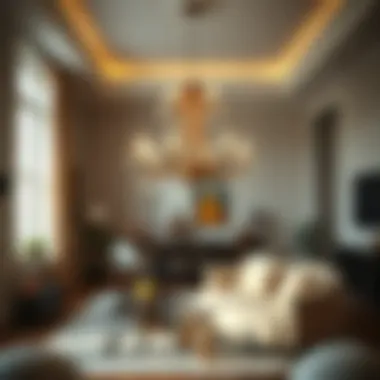
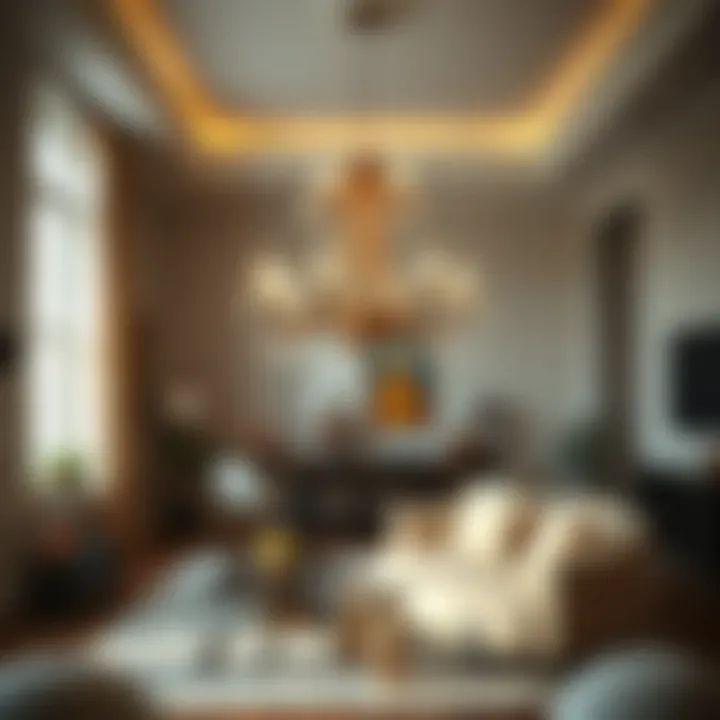
Track lighting offers unparalleled flexibility. Often used in galleries or modern homes, it consists of multiple light fixtures attached to a track system. This allows for the direction of light to be easily adjusted. Whether you want to spotlight artwork on the wall or create an ambiance for entertaining, track lighting can adapt effortlessly to your needs.
One common advantage of track lighting is its ability to mix functionality with style. Available in a range of finishes and designs, it can suit both casual and formal environments. Furthermore, track lighting supports the use of different types of bulbs, making it easy to switch between intense illumination and softer, ambient lighting.
Recessed Lighting
Recessed lighting, also known colloquially as "can lights" or "downlights," can be a game-changer for interior design. These fixtures are installed above the ceiling, resulting in a clean and unobtrusive look. Ideal for providing a uniform glow throughout a room, recessed lights are often used in living spaces and kitchens.
The beauty of recessed lighting is in its versatility. Depending on the types of bulbs used and the placement, they can illuminate a space effectively or create dramatic effects with shadows and highlights. You might choose a warm tone for a cozy vibe or cooler shades for a more modern touch. However, it is crucial to plan their placement carefully; improper spacing can lead to uneven lighting, affecting the overall ambiance.
In summation, understanding the various types of overhead lighting is essential for any homeowner or designer looking to enhance their space. Each type offers distinct benefits and aesthetic appeal, allowing for tailored solutions that meet both functional and design needs. As you navigate your options, consider how each lighting type can work synergistically with your existing decor and desired atmosphere.
Applications of Overhead Lighting
Overhead lighting plays a significant role in various environments, functioning as an essential element in enhancing both aesthetics and practicality. From cozy homes to bustling workplaces, the application of effective overhead lighting can dramatically alter an atmosphere and the way spaces work for their intended purposes. Understanding these applications is key to getting the most out of your lighting setup. It’s not just about illumination; it’s about creating experiences in different contexts.
Living Spaces
Functionality and Atmosphere
When considering living spaces, the concept of functionality coupled with atmosphere cannot be understated. Overhead lighting serves not just to light a room but to establish a mood that resonates with personal style. For instance, a soft, warm light can transform a stark kitchen into a warm gathering space, making family meals cozier. The ease of adjusting luminescence offers flexibility for various activities—from homework to hosting dinner parties.
One striking feature about functionality and atmosphere is how it invites interaction with the environment. Good lighting promotes not only visibility but also an emotional response, catering to residential needs. This dual benefit makes it a popular choice among designers and homeowners alike.
However, there are potential drawbacks. Excessively bright lighting can feel uninviting, while dim lighting may obscure necessary tasks. Thus, striking a balance is crucial. Think of it as a tightrope walk—too much light can overwhelm, and too little can leave one fumbling in the dark.
Balancing Light and Space
Another cornerstone of employing overhead lighting effectively is the art of balancing light and space. The idea is to distribute light evenly across a room, which can help to visually expand cramped quarters or bring a sense of harmony to open areas. A well-lit space can become inviting and functional, steering clear of shadowy corners or overly bright spots.
The unique feature of this concept lies in its adaptability. Utilizing fixtures that direct light strategically can enhance the architectural details of a space or highlight specific areas without overwhelming others. This characteristic greatly contributes to maintaining visual interest while serving practical needs, which is essential for both homeowners and renters.
Yet, it’s not all sunshine and rainbows—achieving a balance requires thoughtful planning and often, trial and error. On occasion, layering several light sources, including task and ambient lighting, may become necessary to avoid glaring discrepancies in brightness.
Commercial Use
Retail Environments
In the retail arena, overhead lighting transforms shopping from a mundane task into a captivating experience. Here, lighting is used as a tool for persuasion, enticing customers to explore products. Featuring attractive displays can increase sales, but it all hinges on the proper application of overhead fixtures. Bright, clear lighting might be used to showcase details in products, like textures and colors.
One of the key characteristics of retail environments is their dynamic nature. They often require different levels of brightness at various times of day, or even depending on the season. This versatility can significantly impact buyer behavior, making it a favorable choice for retailers aiming to maximize their profits.
However, the challenge here is ensuring lighting provisions are energy-efficient while still creating an inviting ambience. Retailers must navigate the tightrope of expenses while maximizing its benefits. Fortunately, modern technology brings solutions, such as LED options that can save energy without sacrificing quality.
Office Spaces
The workplace environment provides another insightful example of overhead lighting’s application. Proper lighting can impact productivity, employee well-being, and overall satisfaction in office spaces. Knowledge workers especially benefit from adequate lighting, as it helps in reducing visual fatigue during long hours of screen time.
A vital characteristic of office spaces is their preference for versatility in lighting solutions. Open office designs frequently employ adjustable fixtures that allow for personalized settings to cater to individual needs. The benefit here is that employees can control their work environment; too often, a sterile bright white light can kill creativity and productivity.
Ultimately, successful implementation requires an understanding of how various light levels can affect mood and performance. Challenges may arise in balancing different areas within the same office—common spaces may need brighter lighting compared to quiet zones. Therefore, periodic assessments of lighting systems might be necessary to ensure all facets adapt to changing needs.
"Lighting is not just a tool; it’s a critical component that shapes our surroundings and influences our experiences within them."
Understanding the applications of overhead lighting in both residential and commercial spaces provides a foundation for enhancing the quality and functionality of these environments. As industries continue to evolve, so, too, does the approach toward atmospheric perfection through thoughtful lighting choices.
The Science of Overhead Lighting
Understanding the science behind overhead lighting is fundamental in maximizing both its functionality and aesthetic appeal in any space. Knowledge of how light behaves, as well as the parameters that govern its efficiency and effectiveness, enables homeowners, renters, and designers to make informed choices. In a world where energy conservation meets the realm of design, incorporating scientific principles can lead to spaces that are both inviting and environmentally friendly.
Understanding Lumens and Watts
When it comes to lighting, lumens and watts are key terms that every homeowner should grasp. Lumens measure the amount of light produced by a bulb, making it a crucial factor in determining brightness. A higher lumen value typically translates to a brighter light. For instance, if you're looking to brighten up your kitchen for tasks like chopping veggies or reading recipes, opting for bulbs that yield a greater lumens count will be beneficial.
On the flip side, watts refer to the amount of energy consumed by the bulb. In traditional incandescent bulbs, higher wattage usually meant brighter lighting, but with advancements in technology such as LED lighting, the relationship between wattage and brightness has become less straightforward. For example, a 10-watt LED bulb can provide about the same lumens output as a 60-watt incandescent bulb, illustrating how energy-efficient bulbs can save you money without sacrificing brightness.
Color Temperature
Color temperature affects not just the look of your space but also the mood it conveys. Measured in Kelvins (K), it describes the warmth or coolness of the light emitted. A lower Kelvin rating, like 2700K, offers a soft yellow or warm white light, creating a cozy and inviting atmosphere, ideal for living rooms and bedrooms. Conversely, a higher rating, such as 5000K, delivers a bright white or even bluish light that mimics daylight, making it perfect for workspaces where alertness and clarity are key.
It's essential to experiment with different color temperatures in individual spaces to find what feels right. Ambient lighting, task lighting, and accent lighting can each benefit from different temperatures, adding depth and versatility to your design.
Energy Efficiency
In an age of rising energy costs and environmental consciousness, energy efficiency is more than just a buzzword—it's a necessity. Efficient lighting options, like LED bulbs or compact fluorescent lights (CFLs), consume significantly less electricity compared to their incandescent counterparts.
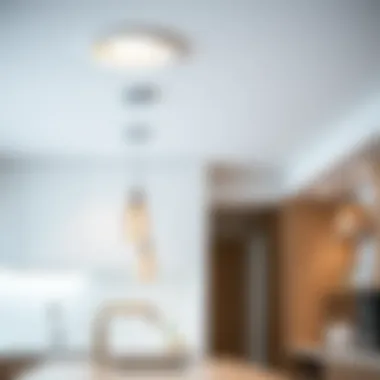
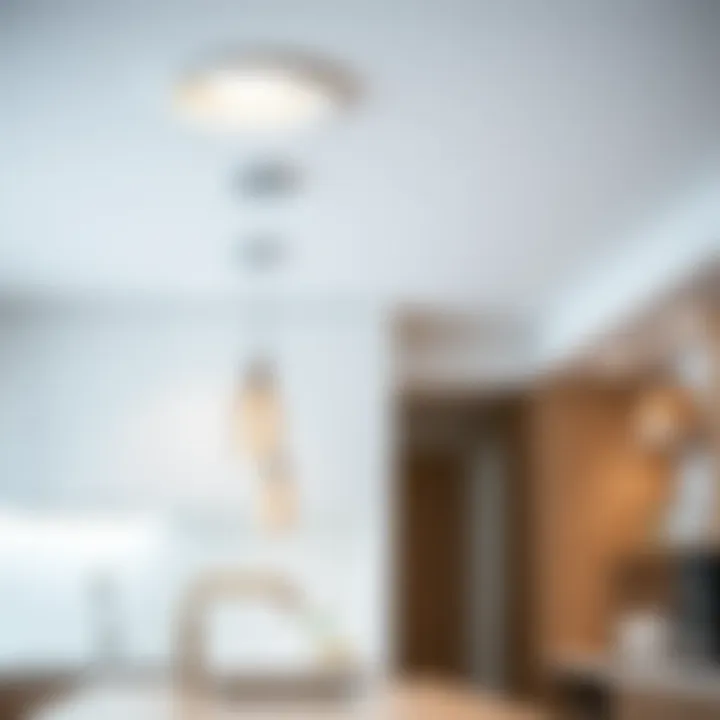
Consider the following benefits of adopting energy-efficient overhead lighting:
- Cost Savings: Over time, lower energy consumption translates to reduced utility bills.
- Longevity: Quality LED bulbs can last up to 25,000 hours, far exceeding the lifespan of traditional bulbs, meaning fewer replacements and waste.
- Reduced Heat: Efficient bulbs generate less heat, putting less strain on air conditioning systems during warmer months.
Transitioning to more energy-efficient lighting practices not only helps the environment but can also elevate the overall aesthetic of your spaces, allowing you to focus on beauty without compromising sustainability.
Choosing the right lighting solution involves understanding both the science behind lighting and the practical needs of your space. A little knowledge can go a long way in striking the right balance between efficiency, functionality, and style.
For more insights on lighting and to delve deeper into energy efficiency strategies, consider visiting Energy.gov and Wikipedia on Lighting. These resources offer valuable information that can help refine your understanding of these science-based aspects in overhead lighting.
Aesthetic Considerations
When it comes to overhead lighting, aesthetics play a crucial role in shaping the overall vibe and utility of any space. The look and feel of your lighting can either harmoniously blend with your decor or stand out as an eyesore. It’s important to keep in mind that light fixtures are not merely functional; they are also integral to the design narrative of a room. By thoughtfully choosing light styles that complement the existing decor and creating focal points with their arrangement, you can elevate a space's character.
Matching Your Decor
Choosing the Right Style
Choosing the right lighting style is akin to picking the perfect dress for a special occasion. It must fit the mood, ambience, and overall theme of the room. Overhead lights can range from sleek and modern to classic and ornate, each type bringing its own flavor to the table. A key characteristic of selecting the appropriate style is how well it resonates with the designs already present in the space. For instance, a minimalist pendant light would be ill-suited for a room laden with Victorian furnishings, as it may clash instead of complement.
Each style, be it industrial, farmhouse, or contemporary, has its own unique features. Industrial lighting tends to incorporate raw materials and bold lines, offering an urban edge, while a farmhouse aesthetic might feature softer lines and warmer elements. A benefit of choosing styles that harmonize with the decor is that they enhance the cohesive feel of the room, allowing the space to breathe and appear intentional.
Color Coordination
Color coordination is another exciting aspect to consider when integrating overhead lighting. The light's color should not only blend with the walls and furniture but also take into account the emotions that colors evoke. A warm yellow cheery hue can create a cozy atmosphere, while a cooler blue or white light might project tranquility and openness.
A key advantage of thoughtful color coordination is how it impacts the visual flow of a space. When a light fixture shares tones with the adjoining colors of upholstery or cabinetry, it contributes to an aesthetically pleasing look that feels effortlessly curated. However, here also lies a pitfall: choose colors that are too jarring or dissimilar to the existing palette, and you risk creating visual chaos that distracts from the design. To maintain balance, one might consider using a color wheel to ensure that the selected hues work harmoniously together.
Creating a Focal Point
Creating a focal point using overhead lighting can significantly transform a room's aesthetic. A well-placed chandelier or a striking pendant light can serve not just as a source of illumination, but also as a statement piece that catches the eye. This focal element draws attention and anchors the design, making the lighting an integral part of the room’s identity.
To successfully achieve this, intuition about placement is key. Hanging lights in the center of dining tables or above islands can underscore the functionality of these spaces, while simultaneously enhancing the visual appeal. When paired thoughtfully with decorations or artwork, overhead lighting can illuminate these elements effectively, further emphasizing the aesthetic flow throughout the room.
Technological Advancements in Overhead Lighting
The world of lighting is changing faster than a kid in a candy store. Technological advancements in overhead lighting have transformed not just the way we illuminate our spaces but also how we interact with light itself. Homeowners, designers, and retailers can all benefit from understanding these innovations, as they carry significant implications for energy efficiency, aesthetic appeal, and overall functionality.
LED Technology
One of the most noticeable breakthroughs in lighting technology has to be the advent of LED lights. Short for Light Emitting Diodes, these marvels are not just energy efficient but also long-lasting. Unlike traditional incandescent bulbs that tend to burn out faster than you can change a light switch, LED bulbs can last over 25,000 hours. This remarkable lifespan means less hassle with frequent replacements.
Additionally, LED technology is remarkably versatile. They come in an array of colors and brightness levels, which means you can customize the light according to the mood you want to create. Want a warm, cozy vibe for a movie night? There’s an LED for that. Need bright white lighting for tackling that DIY project? There’s an LED for that too.
A few benefits of using LED technology include:
- Energy Efficiency: Consuming up to 75% less energy than incandescent bulbs.
- Low Heat Emission: They generate minimal heat, reducing cooling costs, especially during hot months.
- Environmentally Friendly: As LED lights contain no toxic materials, they are a sustainable choice compared to other lighting options.
"Switching to LED lighting can cut energy costs by as much as 50% and reduce the environmental impact."
(Source: www.energy.gov)
Smart Lighting Solutions
If LED lighting revolutionized the way we use light, then smart lighting solutions have taken it a step further, allowing us to control our lights from the palm of our hand. Imagine walking into a room and having the lights adjust automatically based on the time of day or your specific preferences. With smart lighting, this is not just a dream but a reality that many have embraced.
Smart lights, often controlled through apps or voice activation, offer impressive functionalities. They can be programmed to adjust brightness, change colors, or even sync with music. This flexibility makes it easy to set the right ambiance for any occasion, whether it’s a quiet dinner or a lively gathering.
Some key features of smart lighting solutions include:
- Remote Control: Many smart bulbs can be operated from a distance using a smartphone app.
- Voice Activation: Compatible with virtual assistants like Amazon Alexa or Google Assistant, making your life more hands-free.
- Energy Monitoring: Some systems provide data on energy consumption, aiding in cost-effective decisions.
In the end, understanding these technological advancements is essential for anyone interested in enhancing their spaces through overhead lighting. By leveraging both LED technologies and smart lighting solutions, you can create efficient, versatile, and customizable lighting setups that meet your needs and elevate your living spaces.
Sustainable Choices in Overhead Lighting
In today's world, sustainability is priority one for many homeowners and designers. The push towards environmentally friendly design has never been more pronounced, and overhead lighting plays a critical role in this transformation. Incorporating sustainable choices in overhead lighting not only decreases our carbon footprint, but also promotes a healthier living environment. What usually gets lost in the conversation, though, are the specifics of how to implement these choices effectively. This section explores the avenues within sustainable overhead lighting, focusing on eco-friendly materials and energy conservation strategies.
Eco-Friendly Materials
When we talk about sustainability, it often begins with the materials used in the creation of lighting fixtures. Beyond just aesthetics, eco-friendly materials encapsulate a sense of responsibility towards our planet and future generations.
Many manufacturers are now using recycled materials, which reduces the energy and resources needed for production. For example, consider aluminum and glass; both are recyclable and can be crafted into stunning lighting fixtures that blend with various decor styles. Additionally, fixtures made from bamboo and cork are becoming increasingly popular for their rapid renewability and visual warmth.
Choosing low-VOC paints and finishes is another consideration. These not only contribute to better indoor air quality but also show a manufacturer’s commitment to reducing harmful emissions. Using these materials can be seen as a two-for-one: it’s stylish and environmentally sound.


In short, opting for eco-friendly materials in overhead lighting contributes to a circular economy and promotes a narrative of responsibility and thoughtful consumption.
Energy Conservation Strategies
The efficiency of overhead lighting is not just about the choice of bulb; it's about a comprehensive approach to energy savings. One of the most effective energy conservation strategies is selecting LED bulbs. These little wonders consume significantly less energy than their incandescent counterparts while lasting far longer. It’s like getting paid back not just in brightness but also in longevity.
In addition to bulbs, consider the design of your lighting system. Using dimmers can enhance control over illumination levels, allowing you to tailor lighting to your mood or task. This adjustment leads to substantial energy savings over time, especially in spaces frequented by family and guests.
Smart lighting solutions present another opportunity. With smart technology, you can program lights to turn off when not in use or adjust brightness based on the time of day. This takes energy conservation up a notch and is seamless for modern lifestyles.
Overall, employing energy conservation strategies through smart choices in overhead lighting not only reduces energy consumption but also lowers utility bills—an appealing notion for homeowners and renters alike.
"Making sustainable choices in overhead lighting is less about one-time investments and more about cultivating a mindful lifestyle."
Ultimately, the sustainable path in overhead lighting combines material awareness with smart energy practices to foster an environment where aesthetic beauty meets environmental responsibility. As the conversation around sustainability continues to grow, these strategies ensure we can all contribute to a better future while enjoying well-lit spaces.
Installation Considerations
When it comes to overhead lighting, installation is a critical aspect that can mean the difference between an inviting atmosphere and a less-than-ideal space. Proper installation not only enhances the light quality but also ensures safety and functionality throughout its lifespan. Let's explore key elements such as placement, height, and wiring that deserve attention during the installation process.
Placement and Height
Placement of overhead lighting is an often overlooked detail that can profoundly affect the light distribution and ambience of any room. Where you put your fixtures can either make or break the overall lighting experience.
For instance, in a dining area, a chandelier or pendant light is typically positioned around 30 to 36 inches above the table. This height provides sufficient illumination without obstructing views or creating a glare. On the other hand, in a living room, tall ceilings may require a different approach. Installing recessed lights in a staggered pattern can ensure even light distribution, preventing any shadowy corners while maintaining the aesthetic flow of the space.
Considerations regarding the placement should also include whether you'll need task lighting or ambient lighting. Rooms that require focused activity, such as kitchens, may need lights situated above countertops or islands. Balancing these elements assures that each area serves its purpose well.
An unintentional misstep in height or placement can lead to visual discomfort and undermine the functionality of the space. Therefore, it is pivotal to collect measurements accurately before any installation begins.
Wiring and Safety
Ensuring that your overhead lighting is safe and effective goes hand in hand with proper wiring. Understanding the specific requirements for your fixtures is essential. If you’re dealing with multiple fixtures, be mindful of the electrical load. This means ensuring your wiring and circuit can handle the number of lights installed without overloading.
Regardless of a DIY approach or hiring a professional, safety is paramount. Here are some fundamental guidelines:
- Always turn off the power at the circuit breaker to prevent any accidental electrical shock.
- Use the right gauge of wire for your fixtures and applications. For standard fixtures, a 14-gauge wire is common; however, your local codes may differ.
- Secure connections with wire nuts and electrical tape. Inspect the junction boxes to ensure they’re rated for the fixture's weight and intended use.
"Proper wiring safeguards not only your overhead lighting but also the very integrity of your home’s electrical system."
With the proper installation techniques in mind, your overhead lighting can enhance your living space with style and efficiency. It's advisable to consult local building codes and possibly engage an electrician for complex designs or concerns. As the saying goes, better safe than sorry!
Maintenance of Overhead Lighting
Maintaining overhead lighting is not merely a chore; it plays a vital role in ensuring both functionality and aesthetic appeal in any space. Proper maintenance can extend the lifespan of your fixtures, lower energy costs, and contribute to a visually appealing environment. When lights are kept clean and in good working order, they can improve the mood of a room and even enhance safety by illuminating spaces adequately.
Cleaning Techniques
Keeping your overhead lighting clean is essential, yet it’s often overlooked. Accumulated dust and grime can dim the brightness of your fixtures, affecting both their performance and your enjoyment of the space.
Here are some effective cleaning techniques:
- Dusting: Begin with a simple dusting using a microfiber cloth to remove surface dust. This is especially important for fixtures with intricate designs that collect dust easily.
- Use of Mild Cleaners: For tougher stains and residues, a mild cleaner mixed with water can work wonders. Avoid any harsh chemicals which might damage the finish of your light fixtures.
- Unplug and Cool Down: Always turn off power to the fixture before cleaning, and let it cool down if it has been on. Safety comes first!
- Soft Brushes: For chandeliers or other intricate designs, consider using a soft brush to reach into crevices without scratching surfaces.
- Regular Schedule: Try to commit to a regular cleaning schedule—perhaps once a month—especially in areas prone to dust such as kitchens or dining rooms.
"Regular maintenance is the key to keeping your light fixtures shining bright and your home looking its best."
Bulb Replacement Tips
Replacing bulbs in overhead lighting fixtures is crucial for maintaining brightness and efficiency. A burnt-out bulb not only dims a space but can lead to inconvenience and safety hazards.
Here are vital tips for bulb replacement:
- Know the Type: Make sure you know the specific type of bulb your fixture requires, whether it be LED, incandescent, or fluorescent. Different fixtures have different requirements, and using the wrong type can cause issues.
- Check the Wattage: Always check the maximum wattage your fixture can handle to avoid overheating and potential fire risks.
- Turn Off Power: Prior to replacing a bulb, ensure power is switched off to avoid electrical shocks. This is especially important for high fixtures which may require a ladder.
- Wear Gloves: When handling bulbs, especially halogen or LED, consider wearing gloves to prevent oils from your skin from transferring to the bulb, which can cause premature failure.
- Test After Replacement: Once the new bulb is in place, turn the power back on and test to make sure it is working properly.
By taking the time to maintain and replace bulbs in your overhead lighting, you not only enforce the functionality of your living space but also enjoy a well-lit environment that enhances the overall aesthetic.
For more detailed information, you may visit Wikipedia or check home improvement forums on Reddit for discussions and tips shared by DIY enthusiasts.
Culmination
In the realm of interior design, overhead lighting stands tall as a pillar of both function and form. It’s crucial because it not only illuminates spaces but also defines an environment’s mood and character. Just as a painter chooses his hues, designers and homeowners sift through overhead lighting options to create visual harmony while ensuring practicality.
Recap of Key Points
Throughout this comprehensive guide, we've tackled various elements that encompass overhead lighting. Here are the main takeaways:
- Diversity in Styles: From flush mount fixtures to intricate chandeliers, the choices are vast. Each type offers a distinct flair suitable for different spaces and purposes.
- Functionality vs. Aesthetics: Striking a balance is essential. Overhead lighting must fulfill its primary role—providing adequate light—while also enhancing the interior decor.
- Technological Shifts: LED technology and smart lighting solutions are reshaping how we manage and experience lighting in our homes and businesses. These innovations not only improve energy efficiency but also allow for tailored lighting experiences.
- Sustainability Matters: With an increasing focus on eco-friendly materials and energy conservation strategies, selecting overhead lighting that supports sustainable practices is increasingly important.
- Proper Installation: Adequate placement and height, along with thoughtful wiring, can dramatically shift a space’s atmosphere while ensuring safety and efficiency.
Future Trends in Overhead Lighting
The landscape of overhead lighting is not static. As we advance, several trends are becoming increasingly pronounced:
- Integration of Smart Technologies: As homes grow smarter, so does lighting. Expect to see more systems that can be controlled via smartphone or voice commands, enabling homeowners to create customized lighting scenes effortlessly.
- Biophilic Design: This trend, which looks to connect people with nature, is influencing overhead lighting designs. Natural materials and light color temperatures are being favored to create calming environments.
- Minimalist Trends: The less-is-more approach continues to gain traction in lighting design. Simple lines and unobtrusive designs allow for light to take center stage rather than clunky fixtures.
- Artistic Statement Pieces: Investors are not afraid to make bold design statements with overhead lighting. Unique, sculptural pieces are becoming focal points in homes, transforming lighting into art.
- Health-Conscious Options: With growing awareness of how light affects well-being, expect more products that mimic natural daylight and support mental and physical health.





